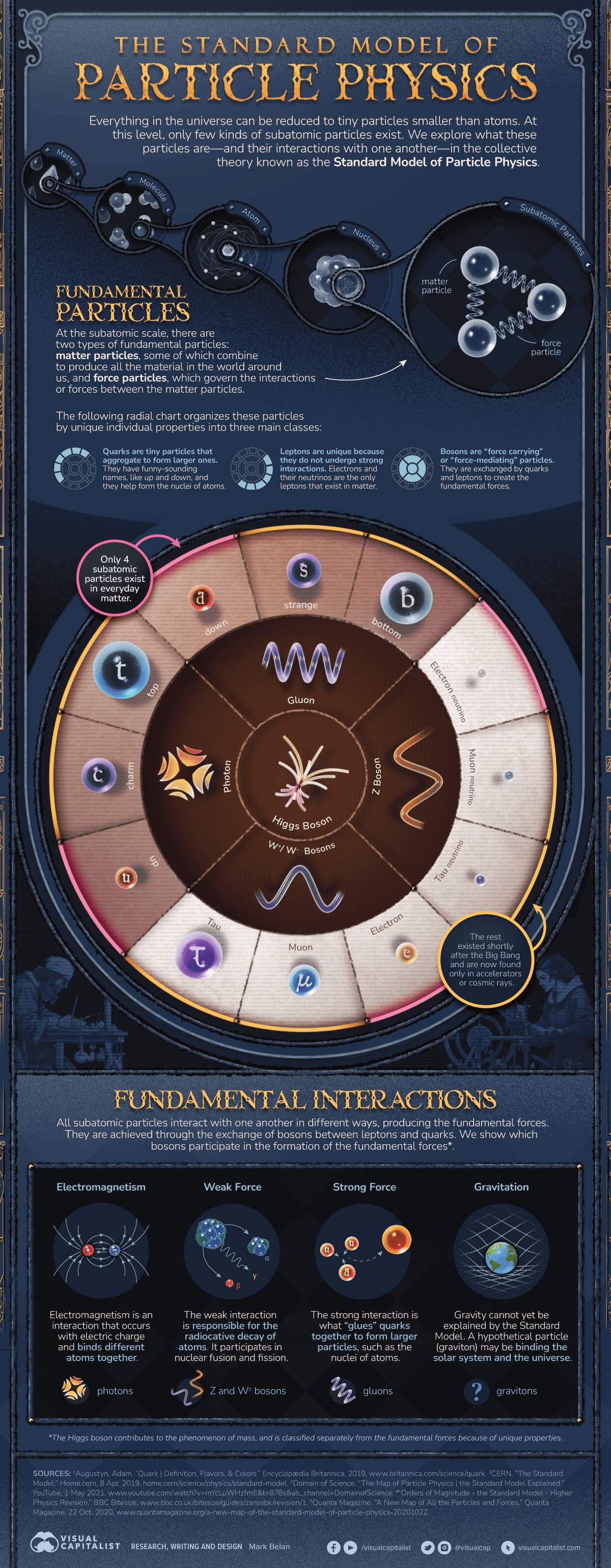
The Standard Model of Particle Physics
You may be familiar with the idea that everything in the universe is made up of matter.
If you take any object and zoom in to its molecular structure, you eventually arrive at the atom—the basic unit of matter, consisting of a nucleus composed of protons and neutrons and surrounded by electrons.
What you might not know is that there are particles that are even smaller than atoms! These are the fundamental particles, and they are the most basic, irreducible components of nature that build atoms and everything around us.
During the latter half of the 20th century, scientists identified a “family portrait” of these subatomic particles and how they interact to create forces in a collective theory known as the Standard Model of Particle Physics. We explore this model and introduce the particles that populate and govern our entire universe.
The Fundamental Subatomic Particles
There are two types of fundamental particles: matter particles, which make up atoms and everything around us, and force particles, which produce the forces that enable matter particles to interact with one another.
At the macro scale, chemical elements appear different to us based on physical properties like appearance, taste, or how they react with one another. At the atomic level, these differences are based instead on unique properties that are more technical and less obvious (i.e. mass, electrical charge, and quantum spin).
| Subatomic Particle | Type |
|---|---|
| Up (u) | Quark |
| Down (d) | Quark |
| Charm (c) | Quark |
| Strange (s) | Quark |
| Top (t) | Quark |
| Bottom (b) | Quark |
| Electron (e⁻) | Lepton |
| Electron neutrino (νe) | Lepton |
| Muon (μ⁻) | Lepton |
| Muon neutrino (νμ) | Lepton |
| Tau (τ⁻) | Lepton |
| Tau neutrino (ντ) | Lepton |
| Photon (γ) | Boson |
| Gluon (g) | Boson |
| W boson (W±) | Boson |
| Z boson (Z⁰) | Boson |
| Higgs boson (H⁰) | Boson |
The fundamental particles are categorized based on their similarities or likeness to these properties. In the Standard Model, these particles can be arranged into three major groups:
-
Quarks
Quarks are matter particles that form in groups of two or three to make larger aggregates. They come in a variety of “flavors’” and are bound tightly together due to a fundamental force called the “strong force.” This quark-binding makes up both the protons and neutrons within the nucleus of an atom.
-
Leptons
Leptons are also matter particles, but differ from quarks because they don’t participate in the strong force. Electrons that whirr around an element’s nucleus are an example of a lepton.
-
Bosons
Bosons are the force-carrying or force-mediating particles. Quarks and leptons exchange them to create the fundamental forces.
It’s interesting to note that, though 17 matter particles have been identified, today only four exist in everyday matter: the “up” and “down” quarks, the electron lepton, and the electron’s neutrino. The rest existed shortly after the Big Bang and now only exist in distant cosmic rays or in accelerators.
Breaking Down the Fundamental Forces
All subatomic particles interact with one another in different ways, producing the fundamental forces (or interactions) mentioned above. When two particles interact, they can exchange bosons between them, which is what mediates the force between the two.
- Electromagnetism is the interaction that occurs with electric charge and binds different atoms together, carried out by the exchange of photons.
- The weak force is responsible for the decay of atoms and happens due to the exchange of Z and W bosons. It participates in nuclear fusion and fission.
- The strong force is what “glues” quarks together to form larger particles, such as the nuclei of atoms. The exchange of gluons results in this force.
One force missing is gravity, which cannot yet be explained by the Standard Model. A hypothetical particle called a graviton may be the binding force that holds the solar system—and the universe—together.
The Future of the Standard Model
The Standard Model is celebrated in modern physics because of its ability to predict and explain the behavior of these particles, but it is still a work in progress.
In the 1960s, Peter Higgs theorized a missing piece of the model’s puzzle that would help explain how particles obtain mass. Dubbed the “Higgs boson” or the “God Particle,” it took a half-century until scientists at CERN in Geneva, Switzerland finally procured it in 2012.
And scientists predict there might still be one other fundamental particle, the graviton. For now, the work to explore subatomic particles and their properties, and advance modern quantum theory and mechanics, continues.
The post Visualized: Subatomic Particles and Fundamental Forces of Nature appeared first on Visual Capitalist.